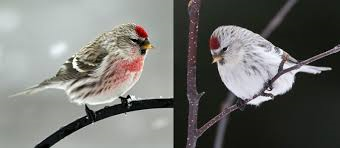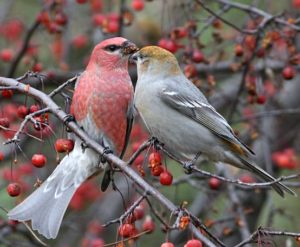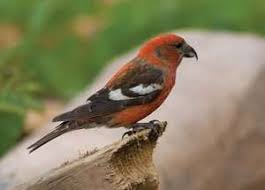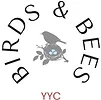Common Redpoll

As energetic as their electric zapping call notes would suggest, Common Redpolls are active foragers that travel in busy flocks. Look for them feeding on catkins in birch trees or visiting feeders in winter. These small finches of the arctic tundra and boreal forest migrate erratically, and they occasionally show up in large numbers as far south as the central U.S. During such irruption years, redpolls often congregate at bird feeders (particularly thistle or nyjer seed), allowing delightfully close looks. Common redpolls can survive temperatures of -54 degrees Celsius (–65 degrees Fahrenheit). During winter, some Common redpolls tunnel into the snow to stay warm during the night. Tunnels may be more than 30 centimeters (12 inches) long and 10 centimeters (4 inches) under the insulating snow.
Hoary Redpoll
A small pale bird of the high Arctic, the Hoary Redpoll is a rare winter visitor to southern Canada and the northern United States. During redpoll invasions, a few paler Hoary Redpolls can sometimes be spotted within flocks of Common Redpolls. Two subspecies of Hoary redpoll are recognized: the Southern— breeds across Canada, Alaska and Eurasia, and is slightly darker and sleeker; and the Greenland form which breeds only in the very high Arctic of Greenland and neighbouring Canada, and is very pale with a large white rump. The Hoary will breed in open tundra, but usually in small willows and other shrubs in sheltered areas. Where suitable nest sites are unavailable, it has been known to nest in cavities of driftwood. The Hoary has very fluffy body feathers that help it to stay warm in extremely cold temperatures. In addition, it has feathers on areas of its body that are bare in most other birds. If temperatures get too high, a redpoll may pluck out some of its body feathers and rid some of its insulation. These feathers will grow back in a few days, but by then in the high arctic environment, temperatures probably will have dropped back to normal.
More Redpoll Facts
Redpolls (both Common and Hoary) have throat pouches for temporarily storing seeds. They may fill their pouches with seeds quickly then fly away to swallow the seeds in a more protected, warmer spot. Redpolls eat up to 42 percent of their body mass every day. They can store up to about 2 grams (0.07 oz.) of seeds in the stretchy part of their esophagus, enough for about a quarter of their daily energy requirement.
The Pine Grosbeak

These birds of the boreal forests are found across northern Eurasia and North America, and south into the mountains of western Canada and the United States. A large, unwary finch, it makes periodic winter irruptions into southern Canada and northern United States. It is the largest and rarest of the “winter finches.”
Red Crossbill

A stocky winter finch of mature coniferous forests, the Red Crossbill is dependent on the seed cones that are its main food. Its peculiar bill allows it access to the seeds, and it will breed whenever it finds areas with an abundance of food.
If you enjoyed this post, we encourage you to signup for our newsletter:
Sign up for our monthly newsletter that keeps you up to date on our in store specials, monthly savings and has great articles about local birds, It also lets you know what upcoming seminars and workshops are happening in our Classroom/Gallery.
By submitting this form, you are consenting to receive marketing emails from: . You can revoke your consent to receive emails at any time by using the SafeUnsubscribe® link, found at the bottom of every email. Emails are serviced by Constant Contact
